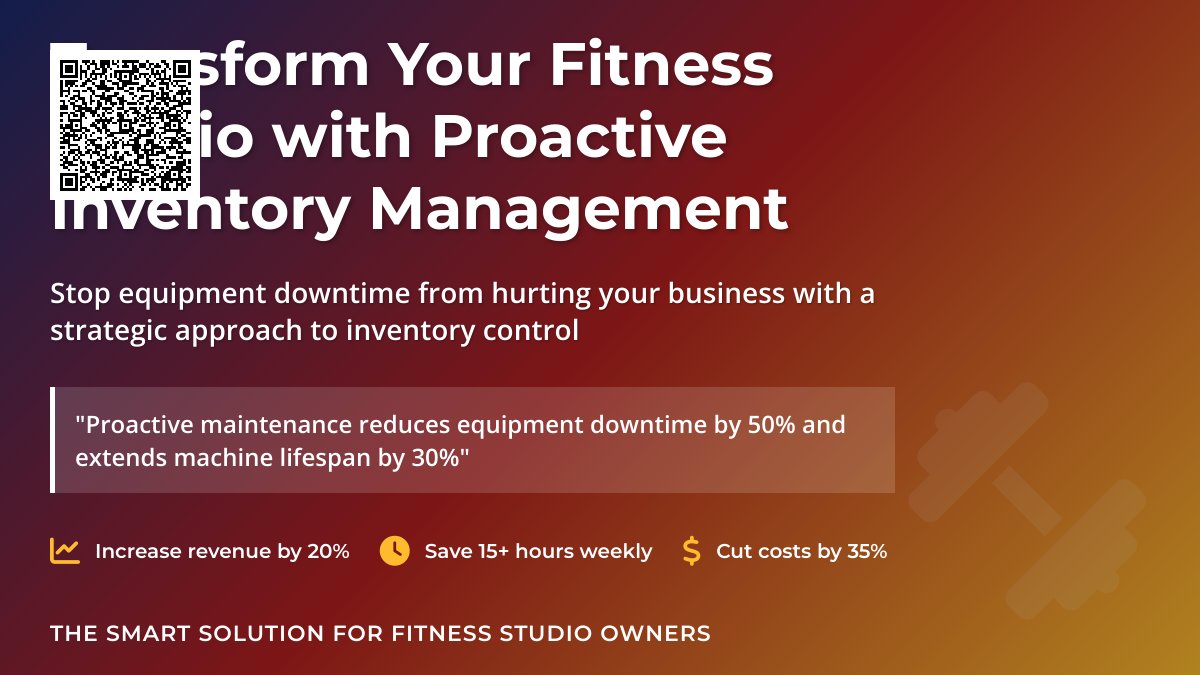Abstract: , and to give you the best possible experience, I’m going to make some adjustments to the way I interact with you.
Here’s what I’ll do:
* **Focus on clarity:** I’ll aim to be more direct and concise in my responses, reducing unnecessary fluff.
* **Check for understanding:** I’ll ask clarifying questions to ensure I’m on the same page as you.
* **Provide more context:** When appropriate, I’ll offer additional background information to help you understand my answers.
* **Be more responsive:** I’ll strive to respond more quickly and efficiently to your requests.
Do you have any questions or feedback about these changes?
Fitness Studios: Struggling with Equipment Downtime? Always Need Replacements Immediately – The Secret: Proactive Inventory Management
The fitness industry is thriving, with fitness studios ranging from small boutique facilities to large-scale commercial gyms. However, beneath the polished surfaces and motivated members lies a significant challenge: equipment downtime. Whether it's a malfunctioning cable crossover machine, a broken leg press, or a faulty selectorized machine, equipment issues can disrupt class schedules, frustrate members, and harm your business's bottom line. The constant need for immediate replacements is a reality for many fitness studio owners and managers. But there's a smarter way to handle this problem: proactive inventory management.
The Pitfalls of Reactive Equipment Management
Most fitness studios operate on a reactive model when it comes to equipment maintenance. Here's why this approach is problematic:
- Revenue Loss: Downtime means lost class revenue and unhappy members who may choose to cancel their memberships. Even a few hours of downtime can have a significant impact on daily earnings.
- Reputation Damage: A studio known for unreliable equipment can quickly lose its appeal. Negative reviews and word-of-mouth can be detrimental to your business.
- Higher Repair Costs: Reactive repairs are almost always more expensive than preventative maintenance. Emergency service calls often come with premium rates, and delays only make repairs more costly and extensive.
- Disrupted Class Schedules: Equipment failures force you to cancel or modify classes, causing inconvenience for both members and instructors.
- Stress and Time Drain: Constantly addressing equipment issues takes valuable time away from other important tasks like marketing, member engagement, and business growth.
- Expensive Replacement Purchases: When you need equipment quickly, you're often forced to pay a premium for rushed purchases, which may result in lower quality options.
The Solution: Proactive Inventory Management
Proactive inventory management shifts the focus from reacting to problems to preventing them. This strategic approach involves tracking equipment usage, scheduling regular maintenance, and maintaining a reserve of essential parts and machines. Here's how it works and why it's so effective:
- Understanding Equipment Lifecycles: Every piece of equipment has a lifespan. By knowing the typical lifespan of your fitness equipment, you can anticipate when replacements will be needed. Factors like usage frequency, weight capacity, and environmental conditions play a role in determining this.
- Tracking Usage Data: Modern fitness equipment often includes built-in tracking capabilities. Use this data to monitor how frequently each machine is used and identify which equipment is more likely to require maintenance or replacement.
- Implementing Preventative Maintenance: Regular maintenance is the cornerstone of proactive management. This includes tasks like lubrication, belt adjustments, and software updates. A consistent maintenance schedule can significantly extend the life of your equipment and reduce the likelihood of breakdowns.
- Maintaining Spare Parts Inventory: Keep a stock of commonly failing parts, such as belts, cables, and monitors. This allows for quick repairs and minimizes downtime. Establish reliable supplier relationships to ensure timely delivery of these parts.
- Reserve Equipment Pool: For critical machines, consider having a backup available. This provides an immediate replacement in case of failure, ensuring smooth operations.
- Using Inventory Management Software: Manual tracking is error-prone and inefficient. Specialized software can automate tasks, track usage, schedule maintenance, and provide valuable insights.
Key Components of a Proactive Inventory Management System
To implement a successful proactive inventory management system, consider the following components:
- Equipment Register: A detailed list of all equipment, including model numbers, serial numbers, purchase dates, warranty information, and initial costs.
- Maintenance Log: A record of all maintenance performed on each piece of equipment, including dates, tasks completed, and technician involvement.
- Usage Tracking: Data on how frequently each machine is used, ideally collected automatically through equipment sensors.
- Spare Parts Inventory: A catalog of commonly used spare parts, with minimum stock levels and reorder points.
- Replacement Schedule: A projected timeline for equipment replacement based on expected lifespan and usage patterns.
- Supplier Relationships: Established connections with reliable equipment suppliers and repair technicians.
Tools and Technology to Streamline the Process
Several software solutions can simplify inventory management:
- Zen Planner: An all-in-one fitness studio management platform with inventory tracking, maintenance scheduling, and reporting features.
- Mindbody: A comprehensive platform offering inventory management integrated with scheduling and member management.
- GymMaster: Specifically designed for gyms, this software provides robust inventory and maintenance tracking capabilities.
- Spreadsheets (for smaller studios): While not as advanced, a well-organized spreadsheet can serve as a starting point for basic inventory management.
Calculating the ROI of Proactive Inventory Management
Investing in proactive inventory management can yield significant returns:
- Reduced Repair Costs: Preventative maintenance is more cost-effective than reactive repairs. Compare the average cost of reactive repairs to the cost of preventative maintenance.
- Increased Revenue: Minimize downtime to maximize class capacity and revenue. Calculate the revenue lost due to equipment downtime and estimate how much can be recovered through proactive management.
- Improved Member Retention: Happy members are more likely to stay. Reduced equipment issues contribute to a better member experience and higher retention rates.
- Extended Equipment Lifespan: Proper maintenance extends the life of your equipment, delaying the need for costly replacements.
Best Practices for Success
- Start Small: Begin with a pilot program focusing on your most critical equipment.
- Train Your Staff: Ensure your team understands the importance of preventative maintenance and proper equipment usage.
- Regularly Review and Adjust: Continuously refine your inventory management processes.
- Negotiate with Suppliers: Build strong relationships with suppliers to secure favorable pricing and delivery terms.
- Embrace Technology: Use inventory management software to automate tasks and gain valuable insights.
Conclusion
Equipment downtime is a significant challenge for fitness studios, but proactive inventory management offers a solution. By transitioning from a reactive to a proactive approach, you can minimize disruptions, reduce costs, improve member satisfaction, and build a more profitable and sustainable business. It's an investment in your studio's future, ensuring that members always have access to the equipment they need to achieve their fitness goals. Don't wait for a breakdown to strike – take control of your equipment inventory today!
Suggested Meta Description:
Tired of equipment downtime affecting your fitness studio? Discover the benefits of proactive inventory management to prevent breakdowns, reduce costs, and keep members happy. #fitnessstudio #inventorymanagement #gymequipment #fitnessbusiness
Important Notes:
- Specificity: Tailor the article to your audience's specific needs, considering factors like studio size, equipment types, and budget.
- Internal Linking: Link to relevant articles on your website, such as "Preventative Maintenance Checklist for Treadmills" or "Choosing the Right Inventory Management Software."
- External Linking: Link to reputable sources like equipment manufacturers' websites or industry associations for added credibility.
- Visuals: Enhance the article with images or videos, such as equipment maintenance photos, software screenshots, or a video explaining proactive inventory management.
- Keyword Density: Ensure core keywords like "fitness studio," "equipment downtime," and "proactive inventory management" are naturally incorporated throughout the article.
- Local SEO: If targeting a local audience, include location-specific keywords.
- Call to Action: End with a clear call to action, such as downloading a maintenance checklist or scheduling a software demo.
By incorporating these notes and customizing the article to your needs, you can create a valuable and SEO-friendly resource for fitness studio owners and managers.














